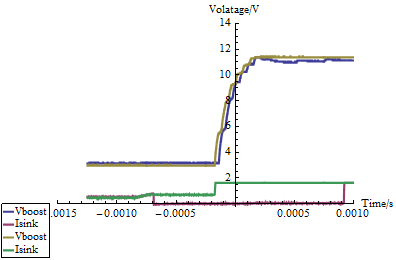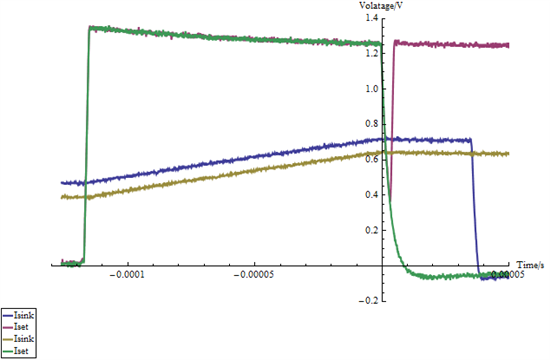- Ask a related questionWhat is a related question?A related question is a question created from another question. When the related question is created, it will be automatically linked to the original question.
This thread has been locked.
If you have a related question, please click the "Ask a related question" button in the top right corner. The newly created question will be automatically linked to this question.
I'm using the TPS65073 to control the backlight consisting of a string of 4 LEDs.
I can always turn the LEDs on (via setting register 0x18 to 0x90), as well as adjust the PWM duty cycle from 0 to 100% (via setting register 0x19 to 0x00 -- 0x63).
If I turn the backlight off (via setting register 0x18 to 0x10), then most, but not all, the time the backlight fails to turn back on. When failing, the boost converter still works -- going to ~12 V. However, the Isink pins fail to sink any current. Once failed, only a power cycle will bring it back to life.
The figure below is an example of the working and non-working condition. Vboost is the voltage at the FB_wLED pin. Isink is the voltage at the Isink1/Isink2 pins (they are tied together). The blue/red pair shows proper operation. The boost voltage comes up, Isink goes low to sink the current. At ~0.8 ms, Isink goes "high" to start the first PWM cycle. The gold/green pair shows the failure. The boost voltage comes up, but Isink fails to go low. At its voltage and the i-v characteristic of the LED string, less than 1 uA flows through the LEDs.

The voltage at Iset2 does something different between the failing and success cases as well, as shown below. In the success case (blue/red), Isink drives low, similar to the plot above. There is a ~4 us glitch in Iset, but apparently it has no effect. In the failure case, (green/gold), Isink does not go low and Iset does not recover from the glitch.

The circuitry is the same as my earlier postings:
backlight circuit values: iset2 = 124 kohm, L4 = 33 uH.
power source either battery, AC, or USB.
Any suggestions would be most appreciated!
I'm unable to replicate your issue on an EVM here in the lab. If you don't have one of these EVM boards (https://estore.ti.com/Search.aspx?detail=1&k=TPS650732EVM-430), it might be a good idea to get one for your troubleshooting. If you would, please send me an updated schematic and layout.
Daniel,
I'd rather not post my schematic. Can I email it to you? What email address should I use?
Thanks,
Quentin
Quentin,
After reviewing you schematic, I have determined the issue to be in your selection of the inductor.
Based on the procedure on pages 64 and 65 of the datasheet, I have calculated that the inductor needs to be rated for a saturation current of 170 mA. You have selected an inductor with a saturation current rating of 40mA which is out of spec.
Daniel,
My inductor is a Coilcraft LPS3015-333ML, with a saturation current of 390 mA.
Please confirm.
Thanks,
Quentin